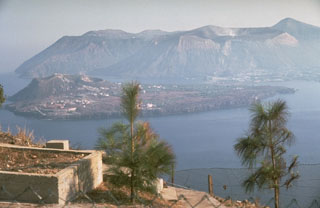Report on Vulcano (Italy) — April 1990
Bulletin of the Global Volcanism Network, vol. 15, no. 4 (April 1990)
Managing Editor: Lindsay McClelland.
Vulcano (Italy) Continued fumarolic activity
Please cite this report as:
Global Volcanism Program, 1990. Report on Vulcano (Italy) (McClelland, L., ed.). Bulletin of the Global Volcanism Network, 15:4. Smithsonian Institution. https://doi.org/10.5479/si.GVP.BGVN199004-211050
Vulcano
Italy
38.404°N, 14.962°E; summit elev. 500 m
All times are local (unless otherwise noted)
A summit climb on 31 March revealed only minor changes since September 1989 (14:10). Gas emission continued from the fissure on the N rim, at high pressure from its 10-15-cm-wide central portion. Rocks up to 5 mm in diameter were re-ejected when thrown into the fissure's central section. The resulting gas plume rose 300-400 m during rainy weather on 3 April, but was considerably smaller at other times. Weak fumarolic activity was also occurring on the outer SE crater wall, and a new fumarole had formed on the NW flank.
Geological Summary. The word volcano is derived from Vulcano stratovolcano in Italy's Aeolian Islands. Vulcano was constructed during six stages over the past 136,000 years. Two overlapping calderas, the 2.5-km-wide Caldera del Piano on the SE and the 4-km-wide Caldera della Fossa on the NW, were formed at about 100,000 and 24,000-15,000 years ago, respectively, and volcanism has migrated north over time. La Fossa cone, active throughout the Holocene and the location of most historical eruptions, occupies the 3-km-wide Caldera della Fossa at the NW end of the elongated 3 x 7 km island. The Vulcanello lava platform is a low, roughly circular peninsula on the northern tip of Vulcano that was formed as an island beginning more than 2,000 years ago and was connected to the main island in about 1550 CE. Vulcanello is capped by three pyroclastic cones and was active intermittently until the 16th century. Explosive activity took place at the Fossa cone from 1898 to 1900.
Information Contacts: B. Behncke, Ruhr Univ.

